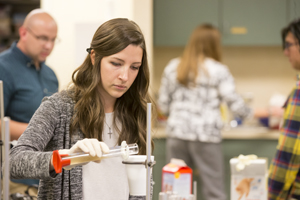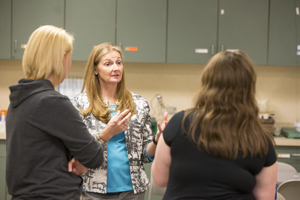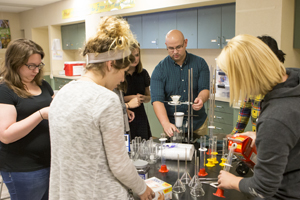Ensuring the Success of Science Educators
Monday, February 20, 2017
This article appears in the 2017 OSU Research Matters magazine.
Julie Angle’s commitment – for preparing future science educators, developing talented science teachers, and inspiring adolescents to pursue STEM careers – drives her teaching, research, and service.
“Knowledge of scientific research is especially important for quality science teachers,” says Angle, an associate professor in the Oklahoma State University College of Education. “It’s important to understand science content, the methods and practices of science and how scientific knowledge is generated. Science does not always come in a neat package; it is often messy. In actuality; you don’t just follow the steps. It’s unpredictable and creative.”
Angle joined the OSU faculty in 2009 and leads the secondary science education program.
She has been lauded for her teaching efforts as a recipient of the Oklahoma 
“For me, research, teaching and service are compiled together,” Angle says.
Angle’s philosophy of preparing science educators through a research lens using an inquiry-based approach is shaped by 25 years of experience teaching high school science, including coaching her students in science fair competitions.
“I saw what (science fair competitions) provided for my students, how it challenged and pushed them further and gave them opportunities to meet people from all over the world,” she explains.
At OSU, Angle has forged strong, collaborative relationships with science and engineering faculty, creating opportunities for her science education students to work closely with faculty and graduate assistants on semester-long research projects.
As part of her Teaching the Nature of Science through an Inquiry Approach course,
Angle matches her preservice science teachers (PSTs) with science faculty and graduate assistants at OSU.
“My science education program would not be the success that it is if it were not for the OSU sciencetists and engineers who volunteer to mentor my students in learning to conduct authentic research,” Angle says. “Many faculty have embraced my PSTs coming into their labs. They understand that if we prepare quality science teachers, then they will prepare their future students to be better prepared college students.”
As PSTs conduct research, they are also being prepared to transition their research into a middle school or high school science lesson. This allows researchers to reach an audience not normally on their dissemination radar. PSTs also present their research, in a poster format, to peers, faculty, graduate students, department heads, and deans at the College of Education PST Research Symposium and Reception.
“I’m known for being demanding, but becoming a quality science teacher takes work” Angle says. “So much of learning about science is through an investigative process.. The beauty is that they are proud of their accomplishments. The work is worth it.”
Each year, Angle also takes her science education students to the National Association of Biology Teachers (NABT) national conference, where many of them have participated in science research competitions with graduate and undergraduate students from all over the country. In the last three years, Angles’ students have won awards at the conference’s Undergraduate/Graduate Mentored Research Poster competition:
2016
Shannon Beck, secondary education science (biology), third place place, “The Painted
Predicament: The Interaction Between Temperature and Food Limitation in Painted Ladies”
based on her work in Dr. Kristen Baum’s lab.
2015
Cassandra Dowds, bachelor’s degree in science education, 2016, first place, The Effect of Embyronic Exposure to Predation Risk on Growth and Antipredator Behavior of Physa acuta,” working with Barney Luttbeg.
Cara Stephens, bachelor’s in zoology 2015, and science education 2016, first place in the Scholarship of Teaching and Learning competition, “Relationship between Instructional Strategies and Student Focus in a Flipped, Introductory-Biology Classroom,” mentored by Donald French.
2014
Kaytlyn Goodwin, bachelor’s in secondary science education 2015, “The Effects of Shade on Setaria virdis, or green millet,” mentored by Andrew Doust.

“For science education students and undergraduates in science, it’s easy to learn content, but difficult to learn the craft and really difficult to model that,” says Doust, an associate professor in of the Department of Plant Biology, Ecology and Evolution,.
“Education research suggests that just ‘doing’ science does not strengthen an individuals’ understanding of the nature of science.” Angle explains. “Using their research experience as the lens to teach about the nature of science has significantly increased preservice and in-service science teachers’ science literacy skills.”
Doust leads a $3 million grant from the National Science Foundation’s Plant Genome Research Program for a project that studies genetic regulation of specialized branches in grasses known as “tillers.” He works closely with Angle to integrate high school science teachers into a research environment and help them gain a better understanding of how scientific knowledge is generated.
Angle and Doust’s model of involving science teachers in research has added support for preservice teachers. Pairing a preservice teacher with an in-service teacher in a summer research experience and extending this working relationship through the following school year has earned rave reviews from the National Science Foundation.
“(We’re helping teachers) get away from the idea that science fairs are about asking only answerable questions; rather it’s about exploring what science is about, exploring the system,” Doust says. “It’s not necessarily about having a hypothesis. We don’t always know the question to ask.”
The partnership has been really productive and Doust notes that he has learned a lot from Angle.
Angle also spearheads two annual events at OSU that reach high school students, the
Junior Science and Humanities Symposium (JSHS) and the award-winning National 
The JSHS regional competition brings talented high school students from Nebraska, Kansas and Oklahoma to the OSU campus each year to present their original research. STEM faculty serve as judges and student winners advance to the national JSHS competition.
During National Lab Day, faculty from five colleges (Education; Arts and Sciences; Engineering, Architecture and Technology; Agricultural Sciences and Natural Resources; and Human Sciences) welcome high school science teachers and their students to Stillwater each May. High school students are paired with STEM research faculty, who expose them to research and STEM majors at OSU. In 2015, the project was awarded first place in the OSU President’s Cup Promoting Creative Interdisciplinary Instruction.
“Julie’s enthusiasm carries these projects with teachers, students and science faculty,” Doust says. “She is very focused and organized and committed to her ideals. Those things make it work.”
